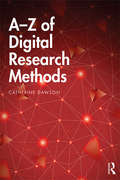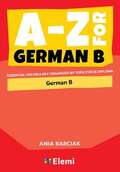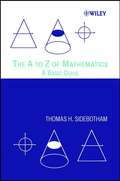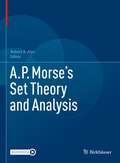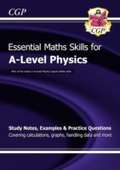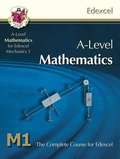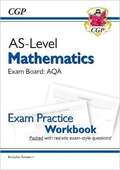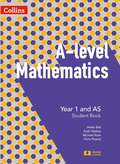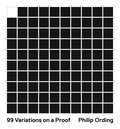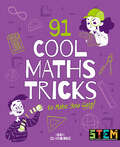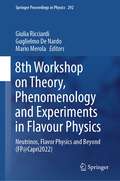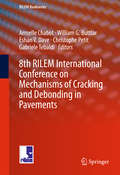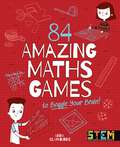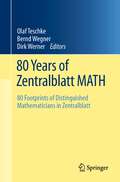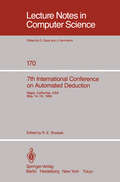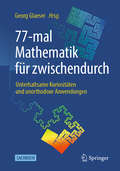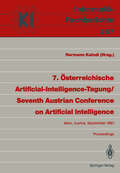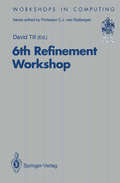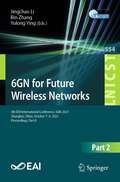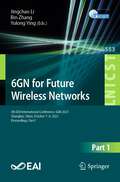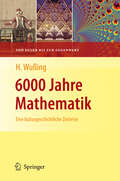- Table View
- List View
A-Z of Digital Research Methods
by Catherine DawsonThis accessible, alphabetical guide provides concise insights into a variety of digital research methods, incorporating introductory knowledge with practical application and further research implications. A-Z of Digital Research Methods provides a pathway through the often-confusing digital research landscape, while also addressing theoretical, ethical and legal issues that may accompany each methodology. Dawson outlines 60 chapters on a wide range of qualitative and quantitative digital research methods, including textual, numerical, geographical and audio-visual methods. This book includes reflection questions, useful resources and key texts to encourage readers to fully engage with the methods and build a competent understanding of the benefits, disadvantages and appropriate usages of each method. A-Z of Digital Research Methods is the perfect introduction for any student or researcher interested in digital research methods for social and computer sciences.
A-z For German B: Essential Vocabulary Organized by Topic for IB Diploma (PDF)
by Ania BarciakPart of the Elemi A-Z series providing students with essential German-English vocabulary to support IB Diploma. Helps students to: Learn and engage with appropriate and varied vocabulary in topic-by-topic lists in line with the prescribed themes and optional sub-topics. Develop fluency in their writing and extend their speaking skills, particularly as part of their oral assessment. Work more independently by offering appropriate and curated support.
The A to Z of Mathematics: A Basic Guide
by Thomas H. SidebothamForget the jargon. Forget the anxiety. Just remember the math. In this age of cheap calculators and powerful spreadsheets, who needs to know math? The answer is: everyone. Math is all around us. We confront it shopping in the supermarket, paying our bills, checking the sports stats, and working at our jobs. It is also one of the most fascinating-and useful-subjects. Mastering math can make a difference in your career, your studies, and your daily life. If you are among the millions of people who would love to understand math but are turned away by fear of its complexity, here is your salvation. The A to Z of Mathematics makes math simple without making it simplistic. Both easy to use and easy to read, the book covers all the topics in basic mathematics. You'll learn the definitions of such terms as "proportion"and "hexomino," and grasp the concepts behind algebra, statistics, and other processes. The book's alphabetical arrangement helps you quickly home in on any topic, and its text is rich with stimulating examples, diagrams, and other illustrations that make the discussion crystal clear to every reader. Everyone will find something of interest in this wide-ranging guide to mathematics. The perfect antidote to math anxiety, this is an invaluable resource for parents and students, home schoolers, teachers, and anyone else who wants to improve his or her math skills and discover the amazing relevance of mathematics to the world around us.
A.P. Morse’s Set Theory and Analysis
This volume explores A.P. Morse’s (1911-1984) development of a formal language for writing mathematics, his application of that language in set theory and mathematical analysis, and his unique perspective on mathematics. The editor brings together a variety of Morse’s works in this compilation, including Morse's book A Theory of Sets, Second Edition (1986), in addition to material from another of Morse’s publications, Web Derivatives, and notes for a course on analysis from the early 1950's. Because Morse provided very little in the way of explanation in his written works, the editor’s commentary serves to outline Morse’s goals, give informal explanations of Morse’s formal language, and compare Morse’s often unique approaches to more traditional approaches. Minor corrections to Morse’s previously published works have also been incorporated into the text, including some updated axioms, theorems, and definitions. The editor’s introduction thoroughly details the corrections and changes made and provides readers with valuable insight on Morse’s methods.A.P. Morse’s Set Theory and Analysis will appeal to graduate students and researchers interested in set theory and analysis who also have an interest in logic. Readers with a particular interest in Morse’s unique perspective and in the history of mathematics will also find this book to be of interest.
A-Level Physics: Essential Maths Skills (PDF)
by Cgp BooksThis brilliant CGP book covers all the maths skills needed in AS and A-Level Physics (the use of maths is required for up to 40% of the marks in the final exams and assessments). It explains Calculations, Geometry, Trigonometry, Graph Skills and Handling Date, with clear study notes and step-by-step examples in the context of Physics. And to make sure you’ve really got to grips with it all, there are practice questions for each topic - with answers included at the back of the book.
A-Level Maths for Edexcel - Mechanics 1: Student Book (PDF)
by Cgp BooksThis student-friendly textbook for the Mechanics 1 Module of A-Level Maths comprehensively covers the Edexcel exam specification. It contains straightforward, accessible notes explaining all the theory, backed up with useful step-by-step examples. There are practice questions throughout the book to test understanding, with recap and exam-style questions at the end of each section (detailed answers to all the questions are included at the back). Finally, there’s a CD-ROM containing two complete Mechanics 1 practice exam papers – ideal to print out for realistic practice before the final tests.
A-Level Maths for AQA: Year 1 & AS Exam Practice Workbook
by Cgp BooksThis CGP Exam Practice Workbook provides plenty of practice to help students prepare for AQA AS-Level Maths. It’s full to the brim with exam-style questions on every topic, plus useful exam tips, fully-worked answers and a mark scheme for every question. There’s even a set of realistic practice exam papers at the end of the book. Don’t miss CGP’s matching AQA AS-Level/Year 1 Complete Revision & Practice book for full notes and examples on every topic
A-level Mathematics: Year 1 and AS Student Book (PDF)
by Chris Pearce Helen Ball Michael Kent Kath HipkissLevel & Subject: AS / A-level Year 1 Maths First teaching: September 2017 First exams: June 2018 Prepare to excel in the new linear A-level Mathematics with this student book suitable for use with all UK exam boards. It covers all the pure, mechanics and statistics content needed for AS and A-level Year 1 for the 2017 A-level Mathematics specifications, and combines comprehensive and supportive explanations with plenty of exam-style practice.
9x13 grid (tactile)
by Adrian FarnsworthThis page shows a grid with axis labelled 0 to 9 and 0 to 13 in braille.
99 Variations on a Proof
by Philip OrdingAn exploration of mathematical style through 99 different proofs of the same theoremThis book offers a multifaceted perspective on mathematics by demonstrating 99 different proofs of the same theorem. Each chapter solves an otherwise unremarkable equation in distinct historical, formal, and imaginative styles that range from Medieval, Topological, and Doggerel to Chromatic, Electrostatic, and Psychedelic. With a rare blend of humor and scholarly aplomb, Philip Ording weaves these variations into an accessible and wide-ranging narrative on the nature and practice of mathematics.Inspired by the experiments of the Paris-based writing group known as the Oulipo—whose members included Raymond Queneau, Italo Calvino, and Marcel Duchamp—Ording explores new ways to examine the aesthetic possibilities of mathematical activity. 99 Variations on a Proof is a mathematical take on Queneau’s Exercises in Style, a collection of 99 retellings of the same story, and it draws unexpected connections to everything from mysticism and technology to architecture and sign language. Through diagrams, found material, and other imagery, Ording illustrates the flexibility and creative potential of mathematics despite its reputation for precision and rigor.Readers will gain not only a bird’s-eye view of the discipline and its major branches but also new insights into its historical, philosophical, and cultural nuances. Readers, no matter their level of expertise, will discover in these proofs and accompanying commentary surprising new aspects of the mathematical landscape.
99 Variations on a Proof
by Philip OrdingAn exploration of mathematical style through 99 different proofs of the same theoremThis book offers a multifaceted perspective on mathematics by demonstrating 99 different proofs of the same theorem. Each chapter solves an otherwise unremarkable equation in distinct historical, formal, and imaginative styles that range from Medieval, Topological, and Doggerel to Chromatic, Electrostatic, and Psychedelic. With a rare blend of humor and scholarly aplomb, Philip Ording weaves these variations into an accessible and wide-ranging narrative on the nature and practice of mathematics.Inspired by the experiments of the Paris-based writing group known as the Oulipo—whose members included Raymond Queneau, Italo Calvino, and Marcel Duchamp—Ording explores new ways to examine the aesthetic possibilities of mathematical activity. 99 Variations on a Proof is a mathematical take on Queneau’s Exercises in Style, a collection of 99 retellings of the same story, and it draws unexpected connections to everything from mysticism and technology to architecture and sign language. Through diagrams, found material, and other imagery, Ording illustrates the flexibility and creative potential of mathematics despite its reputation for precision and rigor.Readers will gain not only a bird’s-eye view of the discipline and its major branches but also new insights into its historical, philosophical, and cultural nuances. Readers, no matter their level of expertise, will discover in these proofs and accompanying commentary surprising new aspects of the mathematical landscape.
91 Cool Maths Tricks to Make You Gasp!
by Anna ClaybourneThis is no ordinary boring math book. Young readers will love this incredible compendium of mind-blowing facts, experiments and fun, interactive activities. Written by award-winning science writer Anna Claybourne, this inspiring book promotes STEM learning with a twist and is ideal for children having trouble learning math. Readers can rediscover subjects such as geometry, statistics, and measurement in a completely new light, learning time-saving tips and tricks for common math problems. Whoever new that math could be this much fun?Includes: • Using math to create uncrackable codes. • Exploring weird numerical patterns. (Did you know that 11111111 x 11111111 = 123456787654321?) • Discovering the secrets of mathematical mind-reading. This brain-boosting book is presented in a neat format with rounded corners and colour illustrations. Featuring a glossary of key terms, it promotes functional problem solving and builds confidence in math. Perfect for readers aged 8+.
8x8 graph (tactile)
by Adrian FarnsworthThis page shows a blank graph with each axis labelled 0 to 8.
8th Workshop on Theory, Phenomenology and Experiments in Flavour Physics: Neutrinos, Flavor Physics and Beyond (FP@Capri2022) (Springer Proceedings in Physics #292)
by Giulia Ricciardi Guglielmo De Nardo Mario MerolaThis book is a collection of invited contributions presented at the 8th edition of the International Workshop on Theory, Phenomenology and Experiments in Flavour Physics, held on the Island of Capri, Italy, on 11–13 June 2022. It is a joint workshop between experimentalists and theoreticians aiming at debating recent results and hot topics in flavour physics, in an interdisciplinary effort. Flavour, electroweak physics and neutrino physics are all foremost in the assessment of results within the standard model and search for physics beyond. Anomalies in flavour physics are hints on new physics, while with neutrino masses and oscillations the new physics has already started. Contributions deal mainly with the flavour anomalies, the flavour problem from leptons to quarks and back, including continuous versus discrete symmetries, and the connections between the Higgs sector and neutrinos, embracing see-saw models and Higgs potential analyses. Focus is on neutrinos, at high and low scales, including LHC searches and CLVF, leptogenesis, connections with dark sectors and NP mediators, non-standard neutrino interactions and the problem of the nature of massive neutrinos.
8th RILEM International Conference on Mechanisms of Cracking and Debonding in Pavements (RILEM Bookseries #13)
by Armelle Chabot William G. Buttlar Eshan V. Dave Christophe Petit Gabriele TebaldiThis book presents the latest advances in research to analyze mechanical damage and its detection in multilayer systems. The contents are linked to the Rilem TC241 - MCD scientific activities and the proceedings of the 8th RILEM International Conference on Mechanisms of Cracking and Debonding in Pavements (MCD2016). MCD2016 was hosted by Ifsttar and took place in Nantes, France, on June 7-9, 2016. In their lifetime, pavements undergo degradation due to different mechanisms of which cracking is among the most important ones. The damage and the fracture behavior of all its material layers as well as interfaces must be understood. In that field, the research activities aims to develop a deeper fundamental understanding of the mechanisms responsible for cracking and debonding in asphalt concrete and composite (e.g. asphalt overlays placed on PCC or thin cement concrete overlay placed on asphalt layer) pavement systems.
84 Amazing Maths Games to Boggle Your Brain!
by Anna ClaybourneThis ingenious book will show young readers just how much FUN maths can be! Strap in for an amazing roller-coaster ride through a world of mathematical games.Written by award-winning science writer Anna Claybourne, this inspiring book promotes maths learning with a twist. Inside you will find intense pen-and-paper puzzles, thrilling two-player games and exciting experiments using ordinary household objects. Young readers can rediscover subjects such as geometry, statistics, and measurement in a completely new light, learning time-saving tips and tricks for common maths problems.Featuring lively illustrations and a glossary of key terms, it promotes functional problem solving and builds confidence in maths. Perfect for readers aged 8+.ABOUT THE SERIES: The STEM in Action series puts maths and science learning into practice, bringing together tricks, games and experiments which involve key STEM concepts. With vibrant, hilarious illustrations, these guides make maths and science accessible and exciting for young readers.
80 Years of Zentralblatt MATH: 80 Footprints of Distinguished Mathematicians in Zentralblatt
by Olaf Teschke Bernd Wegner Dirk WernerFounded in 1931 by Otto Neugebauer as the printed documentation service “Zentralblatt für Mathematik und ihre Grenzgebiete”, Zentralblatt MATH (ZBMATH) celebrates its 80th anniversary in 2011. Today it is the most comprehensive and active reference database in pure and applied mathematics worldwide. Many prominent mathematicians have been involved in this service as reviewers or editors and have, like all mathematicians, left their footprints in ZBMATH, in a long list of entries describing all of their research publications in mathematics. This book provides one review from each of the 80 years of ZBMATH. Names like Courant, Kolmogorov, Hardy, Hirzebruch, Faltings and many others can be found here. In addition to the original reviews, the book offers the authors' profiles indicating their co-authors, their favorite journals and the time span of their publication activities. In addition to this, a generously illustrated essay by Silke Göbel describes the history of ZBMATH.
7th International Conference on Automated Deduction: Proceedings (Lecture Notes in Computer Science #170)
by R. E. ShostakThe Seventh International Conference on Automated Deduction was held May 14-16, 19S4, in Napa, California. The conference is the primary forum for reporting research in all aspects of automated deduction, including the design, implementation, and applications of theorem-proving systems, knowledge representation and retrieval, program verification, logic programming, formal specification, program synthesis, and related areas. The presented papers include 27 selected by the program committee, an invited keynote address by Jorg Siekmann, and an invited banquet address by Patrick Suppes. Contributions were presented by authors from Canada, France, Spain, the United Kingdom , the United States, and West Germany. The first conference in this series was held a decade earlier in Argonne, Illinois. Following the Argonne conference were meetings in Oberwolfach, West Germany (1976), Cambridge, Massachusetts (1977), Austin, Texas (1979), Les Arcs, France (19S0), and New York, New York (19S2). Program Committee P. Andrews (CMU) W.W. Bledsoe (U. Texas) past chairman L. Henschen (Northwestern) G. Huet (INRIA) D. Loveland (Duke) past chairman R. Milner (Edinburgh) R. Overbeek (Argonne) T. Pietrzykowski (Acadia) D. Plaisted (U. Illinois) V. Pratt (Stanford) R. Shostak (SRI) chairman J. Siekmann (U. Kaiserslautern) R. Waldinger (SRI) Local Arrangements R. Schwartz (SRI) iv CONTENTS Monday Morning Universal Unification (Keynote Address) Jorg H. Siekmann (FRG) .
77-mal Mathematik für zwischendurch: Unterhaltsame Kuriositäten und unorthodoxe Anwendungen
Dieses Buch bietet bunt gemischte Beiträge aus Algebra und Logik, Analysis, Geometrie, Zahlentheorie, Stochastik und vielem mehr. Die Artikel sind voneinander unabhängig und können in beliebiger Reihenfolge gelesen werden. Das Buch wendet sich an alle, die sich gerne von unterhaltsamen Kuriositäten und oft unorthodoxen Anwendungen der Mathematik überraschen lassen wollen, insbesondere auch an interessierte SchülerInnen und LehrerInnen. Die einzelnen Beiträge sind sogenannte ,,Mathe-Briefe'', die zwischen 2010 und 2020 von mehr als einem Dutzend österreichischer MathematikerInnen verfasst wurden. Die einzelnen Briefe umfassen meist wenige Seiten und entstanden auf Initiative und unter Betreuung von em. Prof. Gilbert Helmberg (Universität Innsbruck, 1928–2019); sie wurden auf der Webseite der Österreichischen Mathematischen Gesellschaft (ÖMG) veröffentlicht. Der Herausgeber: Georg Glaeser hat die Briefe in Buchform zusammengefasst und als Editor fungiert. Er ist Professor für Geometrie an der Universität für angewandte Kunst Wien und selbst Autor und Koautor einer Reihe von Büchern über Mathematik, Geometrie, Fotografie und Evolutionsbiologie.
7. Österreichische Artificial-Intelligence-Tagung / Seventh Austrian Conference on Artificial Intelligence: Wien, Austria, 24.–27. September 1991 Proceedings (Informatik-Fachberichte #287)
by Hermann Kaindl6th Refinement Workshop: Proceedings of the 6th Refinement Workshop, organised by BCS-FACS, London, 5–7 January 1994 (Workshops in Computing)
by David TillThe Sixth Refinement Workshop took place at City University in London from 5th to 7th January 1994. The present volume includes all of the papers which were submitted and accepted for presentation, together with two papers by invited speakers. The workshops in the series have generally occurred at one year intervals but in this last case a two year period had elapsed. These workshops have established themselves as an important event in the calendar for all those who are interested in progress in the underlying theory of refinement and in the take-up by industry of the methods supported by that theory. One of the proposed themes of the sixth workshop was the reporting of successful adoption in industry of rigorous software development methods. The programme committee was perhaps slightly disappointed by the response from industry to the call in this respect. However, the recent period could be characterised as one of consolidation, when those companies which have made the decision that formal development methods are important to their business have been adopting them where appropriate and finding them to be worthwhile. On the other hand,. the difficult economic climate which exists in most parts of the developed world is perhaps not the context within which companies still dubious about the benefits are goil'\g to opt for making major changes in their working practices.
6GN for Future Wireless Networks: 6th EAI International Conference, 6GN 2023, Shanghai, China, October 7-8, 2023, Proceedings, Part II (Lecture Notes of the Institute for Computer Sciences, Social Informatics and Telecommunications Engineering #554)
by Jingchao Li Bin Zhang Yulong YingThis 2-volume set constitutes the proceedings of the 6th EAI International Conference on 6GN for Future Wireless Networks, 6GN 2023, held in Shanghai, China, in October 7-8, 2023.The 60 full papers were selected from 151 submissions and present the state of the art and practical applications of 6G technologies. The papers are arranged thematically in tracks as follows: intelligent systems; big data mining, D2D communication, security and privacy for 6G networks; artificial intelligent techniques for 6G networks; power and energy systems I; power and energy system; power and energy systems; image, video, and signal processing; image, video, and signal processing & software engineering; communications systems and networking & control and automation systems; computer systems and applications.
6GN for Future Wireless Networks: 6th EAI International Conference, 6GN 2023, Shanghai, China, October 7-8, 2023, Proceedings, Part I (Lecture Notes of the Institute for Computer Sciences, Social Informatics and Telecommunications Engineering #553)
by Jingchao Li Bin Zhang Yulong YingThis 2-volume set constitutes the proceedings of the 6th EAI International Conference on 6GN for Future Wireless Networks, 6GN 2023, held in Shanghai, China, in October 7-8, 2023. The 60 full papers were selected from 151 submissions and present the state of the art and practical applications of 6G technologies. The papers are arranged thematically in tracks as follows: intelligent systems; big data mining, D2D communication, security and privacy for 6G networks; artificial intelligent techniques for 6G networks; power and energy systems I; power and energy system; power and energy systems; image, video, and signal processing; image, video, and signal processing & software engineering; communications systems and networking & control and automation systems; computer systems and applications.
6000 Jahre Mathematik: Eine kulturgeschichtliche Zeitreise - 1. Von den Anfängen bis Leibniz und Newton (Vom Zählstein zum Computer)
by Hans WußingDie Hochkulturen Mesopotamiens und Ägyptens sind die Wiege der Mathematik. Der international angesehene Mathematikhistoriker verfolgt die Geschichte mathematischen Denkens vom 4. Jahrtausend v. Chr. bis zum 20. Jahrhundert. Er schildert die mathematischen Ideen, Methoden und Ergebnisse ebenso wie die Kulturen, in denen sie sich in Wechselwirkung zur Gesellschaft entwickelten. Band 1 umfasst die Zeit von den Ursprüngen bis zum 17. Jahrhundert. Spannende Lektüre für Mathematiker und alle, die sich für Mathematik als Kulturtechnik interessieren.
6000 Jahre Mathematik: Eine kulturgeschichtliche Zeitreise - 2. Von Euler bis zur Gegenwart (Vom Zählstein zum Computer)
by Hans WußingMit dem Namen Euler wird der Beginn der modernen Mathematik verknüpft. Ausgehend von Eulers Leben und seiner wissenschaftlichen Arbeit illustriert der Autor im 2. Teil der mathematisch-kulturhistorischen Zeitreise den Werdegang der heutigen Mathematik. Dabei konzentriert er sich angesichts der hoch komplexen und fragmentierten Entwicklung der Mathematik im ausgehenden 20. Jahrhundert auf wichtige und exemplarische Entwicklungen. Ein spannendes Lesevergnügen für Mathematiker und alle, die sich für die Kulturgeschichte der Mathematik interessieren.
